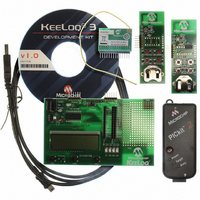DM303007 Microchip Technology, DM303007 Datasheet - Page 24

DM303007
Manufacturer Part Number
DM303007
Description
KIT DEVELOPMENT KEELOQ 3
Manufacturer
Microchip Technology
Type
KeeLoq®r
Datasheet
1.DM303007.pdf
(48 pages)
Specifications of DM303007
Frequency
433.92MHz
Processor To Be Evaluated
PIC16F886
Data Bus Width
8 bit
Interface Type
USB
Silicon Manufacturer
Microchip
Core Architecture
PIC
Core Sub-architecture
PIC16
Silicon Core Number
PIC16F
Silicon Family Name
PIC16F8xxx
Kit Contents
MCU, 2x Programmable Transmitter Boards, Receiver Board,
Rohs Compliant
Yes
Lead Free Status / RoHS Status
Lead free / RoHS Compliant
Lead Free Status / RoHS Status
Lead free / RoHS Compliant, Lead free / RoHS Compliant
K
TABLE 3-1:
3.7
DS41378A-page 20
LED Operation
Sync. Counter
Discrimination Value
SEED Enable
SEED
SEED Button Options
3 T
RF Enable
EE
E
Header
L
PROGRAMMING THE PIC16F636 TRANSMITTER
OQ
®
ENCODER CONFIGURATION OPTIONS
3 Development Kit User’s Guide
3.6.1
Click on the Program button in the toolbar:
Programming progress is displayed in the MPLAB Output window.
After a successful programming, if the option is enabled, the serial code is incremented
and a new programming sequence can start.
The PIC16F636 transmitter is a microcontroller-based solution, allowing the firmware
to be adapted for a particular need. The PIC16F636 K
K
K
All the encoder configuration data, encryption keys, seeds, and serial numbers are
stored into the EEPROM of the PIC16F636.
The MPLAB K
way as programming a hardware encoder. Instead, the K
source code must be loaded into MPLAB. The MPLAB K
memory map for the current encoder options to the EEPROM memory. Programming
is done in the usual way, as when programming a microcontroller.
EE
EE
Two different LED flashing rates are available which correspond to different low battery
indication modes.
Enter a 16-bit hex value (0 through FFFF).
This is the initial value of the synchronization counter.
You can opt for the default setting equal to the 10 LSbs of the serial number or enter an
arbitrary 10-bit value (0 through 3FF).
Select between four modes of operation:
No Seed – disables the Seed transmission feature
Limited Seed – disables Seed transmission when the synchronization counter reaches 80
hex (128)
Permanent and Delayed Seed – Seed transmissions are permanently enabled and
delayed
Permanent Seed only – disables the Delayed Seed Transmission function codes
The Seed is a 60-bit value that can be either random (recommended for Secure Learn
methods) or an arbitrary 60-bit value. It will be transmitted in place of the hopping code
and fixed code portions of the code word when the predetermined Seed function code
(button) is activated.
This field determines what function code will produce an immediate or delayed Seed
transmission.
This option allows you to shorten the synchronization header to 3xT
default value is 10xTE
If enabled, this option produces a high output on the S3 pin before data is transmitted
through the DATA pin. The S3 pin will still be available as a button input, but its
de-bouncing and repeat timing functionality will be affected.
L
L
OQ
OQ
/XTEA, K
encoder license agreement.
Programming the Part
EE
L
EE
OQ
L
OQ
plug-in cannot directly program the microcontroller in the same
/AES source codes are provided by Microchip under the
EE
L
EE
EE
OQ
© 2009 Microchip Technology Inc.
L
L
OQ
OQ
Software encoder
plug-in can export the
software encoder
E
. Otherwise, the











